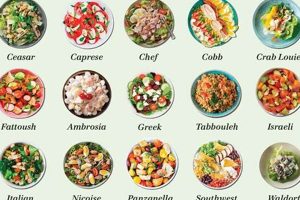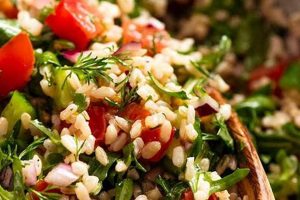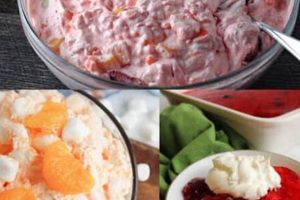A plant-based dish centered around quinoa, this culinary creation combines the complete protein source of quinoa with various vegetables, fruits, nuts, seeds, and a flavorful dressing. Examples include combinations such as roasted sweet potatoes and black beans with a lime vinaigrette, or cucumber, tomato, and parsley with a lemon-tahini dressing. The versatility of quinoa allows for a wide range of flavor profiles and ingredient combinations, making it adaptable to diverse palates and dietary needs.
Such dishes offer a nutritionally dense and satisfying meal option. Quinoa provides essential amino acids, fiber, and minerals, while the accompanying ingredients contribute vitamins, antioxidants, and healthy fats. These salads can be a valuable component of a balanced diet, promoting satiety and contributing to overall well-being. Historically, quinoa has been a staple food in the Andean region for centuries, valued for its nutritional properties. Its recent surge in popularity globally has led to innovative culinary applications, including its prominent role in plant-based cuisine.
Further exploration will delve into specific ingredient combinations, preparation techniques, and variations to create flavorful and nutritious plant-based meals featuring this versatile grain. Considerations for achieving optimal texture and flavor will also be addressed.
Tips for Crafting Exceptional Plant-Based Quinoa Salads
Achieving optimal flavor and texture in a quinoa-based salad requires attention to detail and an understanding of complementary ingredients. The following tips offer guidance for creating delicious and nutritious plant-based meals.
Tip 1: Rinse the Quinoa: Rinsing quinoa under cold water before cooking removes saponins, naturally occurring compounds that can impart a bitter flavor.
Tip 2: Toast the Quinoa (Optional): Toasting dry quinoa in a pan before cooking can enhance its nutty flavor and add a pleasant crunch.
Tip 3: Proper Cooking Technique: Cook quinoa according to package directions, typically using a 2:1 ratio of water to quinoa. Avoid overcooking, which can result in a mushy texture.
Tip 4: Ingredient Selection: Choose a variety of colorful vegetables, fruits, nuts, and seeds to maximize flavor and nutritional value. Consider seasonal produce for optimal freshness.
Tip 5: Balanced Flavor Profiles: Balance flavors by incorporating contrasting elements such as sweet, savory, acidic, and spicy components. For example, pair roasted sweet potatoes with a tangy lime vinaigrette.
Tip 6: Dressing Considerations: Use a high-quality oil and flavorful acid (such as lemon juice or vinegar) as the base of the dressing. Experiment with different herbs, spices, and tahini or nut butters for added depth.
Tip 7: Proper Storage: Store leftover salad in an airtight container in the refrigerator for up to 3 days. Add the dressing just before serving to prevent the salad from becoming soggy.
By following these guidelines, one can create flavorful and nutritious quinoa salads that contribute to a healthy and enjoyable dining experience.
The following section will offer specific recipe examples to illustrate these principles and inspire culinary creativity.
1. Ingredient Selection
Ingredient selection significantly impacts the flavor, texture, nutritional value, and overall success of a vegan quinoa salad. Thoughtful choices create a cohesive and balanced dish, while careless selections can result in a bland or unappetizing meal. The interplay of ingredients contributes to the complexity and satisfaction derived from the salad.
Several factors influence ingredient selection. Seasonality plays a role, as fresh, in-season produce offers optimal flavor and nutritional content. Consideration of flavor profiles is essential, balancing sweet, savory, acidic, spicy, and earthy elements. Textural variety adds interest, contrasting crunchy vegetables with creamy avocado or chewy dried fruit. Nutritional balance ensures the salad provides a complete protein source, fiber, vitamins, and minerals. For instance, combining quinoa with black beans, roasted vegetables, and a lemon-tahini dressing creates a nutritionally complete and flavorful meal. Alternatively, a salad with cucumber, bell peppers, fresh herbs, and a light vinaigrette offers a refreshing and lighter option.
Strategic ingredient selection elevates a simple quinoa salad from basic sustenance to a culinary experience. Balancing nutritional needs with flavor preferences and textural variety allows for endless variations and ensures a satisfying and healthful meal. Understanding the interplay of ingredients empowers informed choices that contribute to a successful and enjoyable culinary outcome.
2. Flavor Balancing
Flavor balancing is paramount in a successful vegan quinoa salad recipe. It transforms a simple combination of ingredients into a harmonious and palatable dish. Without careful attention to flavor, the salad risks being bland, one-dimensional, or even unappetizing. A well-balanced salad engages the palate with a complexity of contrasting yet complementary tastes.
This balance is achieved by strategically incorporating elements representing different flavor profiles: sweetness, sourness, saltiness, bitterness, umami, and spiciness. Sweetness can come from roasted sweet potatoes or dried cranberries. Acidity can be introduced through citrus juice or vinegar in the dressing. Saltiness is essential, but should be used judiciously. Bitterness can be a desirable counterpoint, found in ingredients like kale or radicchio. Umami, often overlooked, adds depth and savoriness; consider incorporating sun-dried tomatoes or toasted nuts. Spiciness, from fresh chilies or chili flakes, provides a stimulating kick. A salad featuring roasted butternut squash, chickpeas, kale, and a maple- Dijon vinaigrette demonstrates this balance, playing the sweetness of the squash against the slight bitterness of kale and the tangy vinaigrette.
Understanding flavor balancing empowers the creation of dynamic and satisfying vegan quinoa salads. It allows for creativity and customization while ensuring the final product offers a complex and enjoyable culinary experience. Ignoring this principle, however, can result in a dish lacking depth and excitement, highlighting the crucial role flavor balancing plays in successful plant-based cuisine. Through thoughtful combination of contrasting tastes, one can elevate a basic quinoa salad to a truly remarkable dish.
3. Texture Considerations
Texture plays a crucial role in the overall enjoyment of a vegan quinoa salad. A successful salad offers a variety of textures that interact harmoniously, creating a more engaging and satisfying sensory experience. Careful consideration of texture elevates the dish beyond mere sustenance, transforming it into a culinary delight. Ignoring textural diversity can result in a monotonous and less appealing meal.
- The Foundation: Cooked Quinoa
Properly cooked quinoa provides a light and fluffy base. Overcooked quinoa becomes mushy and detracts from the overall texture. Achieving the ideal texture involves rinsing the quinoa before cooking and using the correct water-to-quinoa ratio. The slightly chewy texture of well-cooked quinoa serves as a neutral canvas for other ingredients.
- Crunchy Elements
Raw vegetables like chopped cucumbers, bell peppers, carrots, or shredded cabbage introduce a refreshing crunch. Toasted nuts and seeds, such as pumpkin seeds, sunflower seeds, or slivered almonds, contribute another layer of crispness. These contrasting textures create a dynamic interplay within the salad.
- Soft and Creamy Components
Ingredients like avocado, roasted sweet potatoes, or cooked chickpeas offer a softer, creamier contrast to the crunchy elements. These additions contribute a richness and depth to the salad, preventing it from becoming overly dry or brittle. The interplay of soft and crunchy textures enhances the overall sensory experience.
- Chewy Additions
Dried fruits like cranberries, raisins, or chopped apricots introduce a chewy texture that complements the other components. These additions also contribute a touch of sweetness, further enhancing the flavor profile of the salad. The subtle chewiness adds another dimension to the textural landscape.
The interplay of these various texturesthe fluffy quinoa, crunchy vegetables, creamy avocado, and chewy dried fruitcreates a dynamic and satisfying sensory experience. A well-considered balance of textures elevates the vegan quinoa salad from a simple dish to a more complex and enjoyable culinary creation. This attention to detail distinguishes a thoughtfully prepared salad from a hastily assembled one.
4. Nutritional Value
Nutritional value represents a cornerstone of a well-composed vegan quinoa salad recipe. These salads offer the potential for a nutritionally dense and balanced meal, contributing significantly to overall dietary health. Understanding the nutritional components and their interplay allows for informed ingredient selection and recipe development, maximizing health benefits.
- Complete Protein Source
Quinoa is a complete protein, meaning it contains all nine essential amino acids the body cannot produce on its own. This characteristic is particularly important in vegan diets, which may sometimes lack complete protein sources. Combining quinoa with legumes, such as black beans or chickpeas, further enhances the protein profile of the salad, ensuring adequate intake of these essential nutrients.
- Fiber Content
Both quinoa and many common salad vegetables are excellent sources of dietary fiber. Fiber promotes digestive health, helps regulate blood sugar levels, and contributes to feelings of satiety. A fiber-rich salad can support weight management and reduce the risk of chronic diseases. Incorporating ingredients like leafy greens, cucumbers, and bell peppers further boosts the fiber content.
- Micronutrient Density
Vegan quinoa salads can be packed with essential vitamins and minerals. Dark leafy greens provide vitamins A and K, while colorful vegetables like bell peppers and tomatoes contribute vitamin C. Nuts and seeds offer healthy fats, including omega-3 fatty acids, and minerals like magnesium and zinc. The diverse array of ingredients in these salads ensures a broad spectrum of micronutrients.
- Low Glycemic Index
Quinoa has a relatively low glycemic index (GI), meaning it does not cause a rapid spike in blood sugar levels. This characteristic makes it a suitable choice for individuals managing blood sugar levels or following a low-GI diet. Combining quinoa with other low-GI foods, such as non-starchy vegetables, further contributes to a balanced and stable blood sugar response.
The nutritional value of a vegan quinoa salad contributes significantly to its role as a healthful and satisfying meal option. The combination of complete protein, fiber, micronutrients, and a low glycemic index makes these salads a valuable component of a balanced and nutritious plant-based diet. Strategic ingredient selection and mindful preparation techniques maximize these nutritional benefits, contributing to overall well-being.
5. Preparation Techniques
Preparation techniques significantly influence the final outcome of a vegan quinoa salad recipe. Proper execution of these techniques ensures optimal flavor, texture, and overall quality. From the initial rinsing of the quinoa to the final assembly of the salad, each step contributes to the creation of a successful dish. Overlooking or mishandling these techniques can compromise the final product, resulting in a less satisfying culinary experience.
- Quinoa Cooking
Proper quinoa cooking is fundamental. Rinsing the quinoa removes saponins, which can impart a bitter flavor. The correct water-to-quinoa ratio, typically 2:1, ensures proper cooking without resulting in a mushy texture. Bringing the water to a boil before adding the quinoa and then reducing the heat to a simmer promotes even cooking. Fluffing the cooked quinoa with a fork after it has rested allows steam to escape and creates a light and airy texture, ideal for salads.
- Vegetable Preparation
Vegetable preparation techniques contribute significantly to the flavor and texture of the salad. Roasting vegetables, such as sweet potatoes or bell peppers, intensifies their sweetness and adds a caramelized depth. Blanching vegetables, like green beans or broccoli, preserves their vibrant color and crisp-tender texture. Raw vegetables, such as cucumbers or tomatoes, offer a refreshing crunch and contribute to the overall vibrancy of the salad. The choice of preparation technique depends on the desired flavor and texture profile.
- Dressing Emulsification
Creating a stable and flavorful dressing is essential for a successful quinoa salad. Emulsification, the process of combining oil and an acidic liquid like vinegar or citrus juice, creates a creamy and cohesive dressing that coats the ingredients evenly. Whisking the dressing vigorously or using a blender helps to create a stable emulsion. The addition of emulsifying agents like Dijon mustard or tahini further enhances the stability and creaminess of the dressing, preventing separation and ensuring a harmonious blend of flavors.
- Ingredient Combination and Timing
The timing of ingredient combination plays a role in the final quality of the salad. Adding delicate ingredients, like fresh herbs or avocado, just before serving prevents them from wilting or oxidizing. Heartier ingredients, such as roasted vegetables or cooked beans, can be added earlier. Properly combining ingredients ensures optimal flavor and texture, preventing the salad from becoming soggy or losing its vibrancy. Thoughtful timing preserves the integrity of each ingredient, contributing to a more enjoyable culinary experience.
Mastery of these preparation techniques is essential for creating a truly exceptional vegan quinoa salad. Careful attention to each step, from rinsing the quinoa to combining the ingredients, contributes to the overall quality and enjoyment of the dish. These techniques are not merely procedural steps, but integral components of the recipe, influencing the final flavor, texture, and nutritional value. By understanding and implementing these techniques, one can transform simple ingredients into a complex and satisfying culinary creation.
Frequently Asked Questions
This section addresses common inquiries regarding the preparation and enjoyment of vegan quinoa salads.
Question 1: How can bitterness in quinoa be avoided?
Rinsing quinoa thoroughly under cold water before cooking removes saponins, the naturally occurring compounds responsible for potential bitterness.
Question 2: What is the ideal water-to-quinoa ratio for cooking?
A 2:1 ratio of water to quinoa is generally recommended. However, specific package instructions should always be consulted.
Question 3: How can one prevent a mushy texture when cooking quinoa?
Avoiding overcooking is crucial. Following the recommended cooking time and water ratio helps achieve a light and fluffy texture. Fluffing with a fork after cooking also helps release steam and prevent stickiness.
Question 4: How long can a prepared vegan quinoa salad be stored?
Properly stored in an airtight container in the refrigerator, these salads typically last up to three days. Adding dressings just before serving helps maintain optimal texture and prevents sogginess.
Question 5: Can quinoa salads be frozen?
While freezing is possible, it is generally not recommended, as the texture of the vegetables can be compromised upon thawing. Freshly prepared salads offer optimal flavor and texture.
Question 6: How can nutritional value be maximized in these salads?
Incorporating a variety of colorful vegetables, legumes, nuts, and seeds enhances the nutritional profile. Choosing seasonal produce maximizes nutrient density and flavor.
Understanding these aspects contributes to a more successful and enjoyable culinary experience with vegan quinoa salads. Attention to preparation techniques and ingredient selection ensures optimal flavor, texture, and nutritional value.
The following section provides specific recipe examples to further illustrate these principles.
Vegan Quinoa Salad Recipe
Exploration of the vegan quinoa salad recipe has revealed its potential as a versatile and nutritious culinary creation. Key elements, including ingredient selection, flavor balancing, texture considerations, nutritional value, and preparation techniques, contribute significantly to the overall success and enjoyment of this dish. Strategic combination of diverse ingredients, coupled with mindful preparation methods, yields a salad that satisfies both the palate and the body’s nutritional requirements. From the nutty base of quinoa to the vibrant array of accompanying vegetables, fruits, nuts, and seeds, each component plays a crucial role in the final composition.
The adaptability of the vegan quinoa salad recipe allows for endless variations, catering to a wide range of dietary preferences and culinary desires. Continued exploration and experimentation with diverse ingredients and flavor profiles promise further culinary innovation within the realm of plant-based cuisine. This adaptable recipe represents not only a satisfying meal option but also a testament to the versatility and potential of plant-based ingredients in creating flavorful and nutritious dishes.






